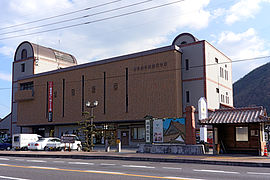Bizen pottery
Bizen ceramics ( Japanese 備 前 焼 , Bizen-yaki ) is the general name for Japanese ceramic products that are mainly produced in the Bizen area, which today corresponds roughly to Okayama Prefecture . After Tokoname, Bizen is the oldest of the "Six ancient kiln sites in Japan" ( Rokkoyō ). Their dark red to brown color is characteristic. The old town of Inbe, which is now part of Bizen, is considered the center of Bizen ceramics .
overview

Like Mino ceramics , Bizen ceramics go back to Sue ceramics from the Heian period . In the first half of the Heian period, potters who made Sueki migrated to the Bizen area, where they founded the Inbe pottery center and initially also made gray Sue ceramics using a reduction fire. At the end of the 12th century, the enlargement of the tunnel kilns into large kilns called Ōgama made it possible to increase production. In addition, a fire at higher temperatures was now possible, which resulted in a change from reduction to oxidation . A large number of large storage vessels were manufactured during this time.
At the end of the 16th century, the addition of iron-containing clay resulted in the dark red to chestnut brown color that is still typical today. In 1582, Toyotomi Hideyoshi , who was Bizen's military governor and tea lover, selected six of the best families for making tea sets. These included the Kaneshige, Kimura, Mori, Hayami, Ohan and Terami families, the first three of which are still active today. The ceramics created during this time are also called old Bizen ceramics ( 古 備 前 , Ko-Bizen ). As a result, tea ceramics, with various fire effects from the Muromachi to the Momoyama period, flourished.
In the Edo period, the production of Bizen ceramics was supported by the local Ikeda dynasty. During this time, the potters in the Bizen region mainly produced figurative ceramics ( 細 工 物 , saikumono ), tableware and sake bottles. As a reaction to the competition that arose with white porcelain from Hizen and Kyōto, white ( gofun-bizen ) and colored ( 色 絵 備 前 , iroe-bizen ) ceramics were also produced in Bizen for a time . The spread of the hillside ovens ( noborigama ) at the beginning of the 19th century also brought inexpensive mass production with it, so that Bizen ceramics, now without protection, fell into a crisis during the Meiji period . Kaneshige Tōyō , descendant of one of the families selected by Hideyoshi, who was named a Living National Treasure in 1956 , managed to revive the tradition of old Bizen ceramics with the production of saikumono .
Types of Bizen Pottery
The Bizen ceramic is fired relatively gently at low temperatures around 1000 ° C and long firing times. Since ash particles do not always melt completely at this low temperature, this is also a characteristic of the glaze.
- Sesame seed glaze ( 胡麻 , goma ): with sesame grain-like glaze spots that are created by fly ash during the firing process
- metallic gray-blue Bizen ceramics ( 桟 切 り , sangiri ): the color arises accidentally through reduction during the firing process, when the surface is covered with ash and cannot be reached by fire and air
- Bizen ceramics with a fire cord pattern ( 緋 襷 , hidasuki ): by wrapping the blank with straw that has been soaked in salt water, the sodium in the table salt reacts with the iron-containing clay in the oxidizing atmosphere. The result is red streaks on the ceramic
- Bizen ceramics with reddish spots ( 牡丹 餅 , botamochi ): by covering the blank with balls of fire-resistant clay (so-called fire clay), round spots with a reddish color are created during firing
- blue Bizen ceramics ( 青 備 前 , ao Bizen ): the color is created by completely covering with straw during the firing process
- Fuseyaki ( 伏 せ 焼 ): Ceramic with different colors, which is created by partially covering the surface
- black Bizen ceramics ( 黒 備 前 , kuro Bizen ): ceramics produced by reduction firing similar to the original old Bizen ceramics
- Enokihada ( 榎 肌 ): Pottery that is fired at a low temperature so that the ashes that cover the surface of the pottery through flight of ash no longer melt out. The surface then resembles the skin of the Enoki mushroom
- Change of fire ( 火 変 わ り , higawari ): by changing from reduction to oxidation fire during the burning process, tones from red-violet to dark gray are generated
Cultural asset
In the city of Bizen there are three large tunnel kilns ( ōgama ) that have been declared historical sites. These are the northern, southern and western Inbe-Ōgama, which are differentiated according to their location. The Tempō kiln ( 天保 窯 ) was also named a municipal cultural asset .
In addition, the Bizen pottery can also be seen in several local museums such as the Fujiwara Kei Museum, which was built in memory of the ceramic artist of the same name and living national treasure. In addition to Kei Fujiwara and his son Yū Fujiwara , three other ceramic artists were honored as a living national treasure in the Bizen ceramics category. Every year on the third weekend in October, the Bizen Pottery Festival is celebrated.
photos
See also
- List of Living National Treasures of Japan (Handicrafts)
- List of Japanese ceramics and pottery workshops
literature
- Bizen . In: Gabriele Fahr-Becker (Ed.): East Asian Art . 2nd (reprint) edition. Tandem Verlag, 2011, ISBN 978-3-8331-6099-8 , pp. 591-592 .
- Anneliese and Wulf Crueger: Paths to Japanese Ceramics . 2nd Edition. Ernst Wasmuth Verlag, Tübingen, Berlin 2012, ISBN 978-3-8030-3359-8 , pp. 120-128 .
Web links
- 備 前 焼 に つ い て . Kibido, 2014,accessed January 19, 2015(Japanese).




